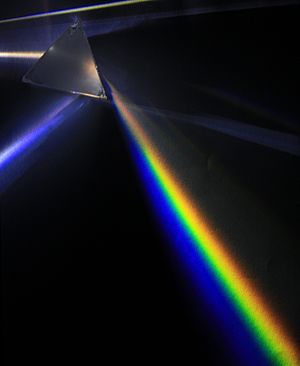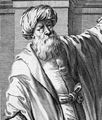Optics facts for kids
Optics is the study of light and how it behaves. It helps us understand why we see rainbows, how light bounces off mirrors, and how it bends when it goes through glass or water. Optics also explains how a prism can split light into different colors.
This science looks at not just the light we can see (like red, orange, yellow, green, blue, indigo, and violet), but also invisible parts of the electromagnetic spectrum. Visible light is only a tiny part of this much larger spectrum.
Optics is both a science and a type of engineering. It has led to many useful inventions. These include eyeglasses, cameras, telescopes, and microscopes. Many of these tools use lenses. Lenses can gather and focus light. They can make images appear bigger or smaller than they really are.
Even though optics is an old science, new discoveries are still being made. Scientists have learned how to send light through very thin optical fibers. These fibers are made of glass or plastic. Light can travel very long distances inside them. Optical fibers are now used to carry phone calls and Internet data between cities and even countries.
Contents
What is Light and How it Behaves?
Light is a form of energy that travels in waves. When light hits something, it can do different things. It can bounce off, pass through, or be absorbed. Optics studies all these actions.
Light's Journey: Reflection and Refraction
When light hits a smooth surface, like a mirror, it bounces back. This is called reflection. It's how you see yourself in a mirror. The angle at which light hits the surface is the same angle at which it bounces off.
When light passes from one material to another, like from air to water, it bends. This bending is called refraction. It happens because light changes speed as it moves through different materials. This is why a straw in a glass of water looks bent.
Splitting Light: Dispersion
When white light, like sunlight, passes through a prism, it splits into all the colors of the rainbow. This is called dispersion. Each color of light bends at a slightly different angle. This is because each color has a different wavelength. Blue light bends more than red light. Rainbows are a natural example of dispersion. Water droplets in the air act like tiny prisms.
Tools and Inventions from Optics
Optics has helped us create many important tools. These tools help us see things far away, very close up, or even things we can't normally see.
Lenses: Magnifying and Focusing
A lens is a curved piece of transparent material, usually glass or plastic. Lenses are designed to bend light in a specific way. They can make objects look bigger or smaller.
- Eyeglasses use lenses to correct vision problems. They help light focus correctly on the back of your eye.
- Cameras use lenses to focus light onto a sensor or film. This creates a clear image of what you are photographing.
- Telescopes use lenses or mirrors to gather light from distant objects. They make faraway stars and planets appear closer and brighter.
- Microscopes use lenses to magnify tiny objects. They help us see things like cells or bacteria that are too small to see with our eyes alone.
Modern Optics: Fibers and Lasers
In modern times, optics has led to even more amazing technologies.
- Optical fibers are very thin strands of glass or plastic. They can carry light signals over long distances. These fibers are used for fast internet connections and phone calls. They send information as pulses of light.
- Lasers are devices that produce a very strong, focused beam of light. Lasers are used in many ways. They can read barcodes, play CDs and DVDs, and even perform delicate surgeries. Scientists also use powerful lasers for research.
Images for kids
-
Alhazen (Ibn al-Haytham)
-
Reproduction of a page of Ibn Sahl's manuscript showing his knowledge of the law of refraction.
-
The first treatise about optics by Johannes Kepler, Ad Vitellionem paralipomena quibus astronomiae pars optica traditur (1604)
-
Dispersion: two sinusoids propagating at different speeds make a moving interference pattern. The red dot moves with the phase velocity, and the green dots propagate with the group velocity. In this case, the phase velocity is twice the group velocity. The red dot overtakes two green dots, when moving from the left to the right of the figure. In effect, the individual waves (which travel with the phase velocity) escape from the wave packet (which travels with the group velocity).
-
The effects of a polarising filter on the sky in a photograph. Left picture is taken without polariser. For the right picture, filter was adjusted to eliminate certain polarizations of the scattered blue light from the sky.
-
Experiments such as this one with high-power lasers are part of the modern optics research.
-
VLT's laser guide star
-
A colourful sky is often due to scattering of light off particulates and pollution, as in this photograph of a sunset during the October 2007 California wildfires.
See also
 In Spanish: Óptica para niños
In Spanish: Óptica para niños

















